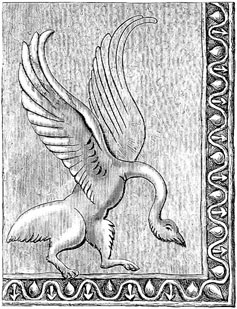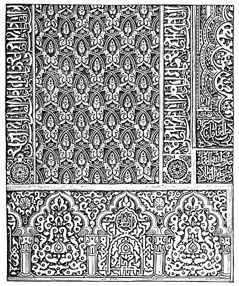1902 Encyclopedia > Mural Decoration > Mural Decoration Methods: (4) Wall Coverings of Hard Stucco, Frequently Enriched with Reliefs.
Mural Decoration
(Part 4)
MURAL DECORATION - INTRODUCTION; METHODS
(4) Wall Coverings of Hard Stucco, Frequently Enriched with Reliefs.
4. Wall-Coverings of Hard Stucco, frequently enriched with Reliefs.—The Greeks and Romans possessed the secret of making a very beautiful hard kind of stucco, creamy in colour, and capable of receiving like that of marble; it would exposure to the weather. Those of the early Greek temples which were built, not of marble, but of stone, such as the Doric temples at Aegina, Phigaleia, Paestum, and Agrigentum, were all entirely coated inside and out with this beautiful –itself pleasant both in texture and hue, and an admirable surface for the further polychromatic decoration with which all Greek buildings seem to have been ornamented. Another highly artistic use of stucco among the Greeks and Romans for the interiors of buildings consisted in covering the walls and vaults with a smooth coat, on which still wet the outlines of figures, groups and other ornaments were sketched with a point; more stucco was then applied in lumps and rapidly modelled into delicate reliefs before it had time to set. Some tombs in Magna Graecia of the 4th century B.C. are decorated in this way with figures of nymphs, cupids, animals, and wreaths, all of which are models of grace and elegance, both in form and action, and extremely remarkable for the dexterous way in which a few rapid touches of the modelling tool or thumb have produced a work of the highest artistic beauty and spirit (fig. 3).

Fig. 3 -- Modelled Stucco Wall-Releif, from a Tomb in Magna Graeca. About half full size.
Roman specimens of this sort of decoration are very common, fine examples have been found in the baths of Titus and numerous tombs near Rome, as well as in many of the houses of Pompeii. These are mostly executed with great skill and frequently with good taste, though in some cases, especailly at Pompeii, elaborate architectural compositions with awkward attempts at effects of violent perspective, modelled in slight relief on flat wall-surfaces, produce a very unpleasing effect. Other Pompeian examples, where the surface is divided into flat panels, each containing a figure or group, have great merit for their delicate richness of effect, without offending against the canons of wall-decoration, one of the first conditions of which is that no attempt should be made to disguise the fact of its being a solid wall and a flat surface.
The Moslem architects of the Middle Ages, who excelled in almost all possible methods of mural decoration, made great use of stucco ornament in the most elaborate and magnificent way, both for external and internal walls. The stucco is modelled in high or low relief in great variety of geometrical patterns, of wonderful beauty and richness, alternating with bands of more flowing ornament, or long Arabic inscriptions. Many of their buildings, such as the mosque of Tulún at Cairo (879 A. D.), owe nearly all their beauty to this fine stucco work, the purely architectural shell of the structure being often quite simple and devoid of ornament. These stucco reliefs were, as a rule, further decorated with delicate paintings in gold and colours, producing an effect of indescribable beauty and splendour. The Moorish tower at Segovia in Spain is a good example of this class of ornament used externally. With the exception of a few bands of brick and the stone quoins at the angles, the whole exterior of the tower is covered with a network of stucco reliefs in simple geometrical patterns. The Alhambra at Granada and the Alcazar at Seville have the richest examples of this work, both in the delicate intricacy of the designs and in the brilliant colours with which they are painted. The lower part of the walls is lined with marble or tiles to a height of about 4 feet, and above that in many cases the whole surface is encrusted with these reliefs, the varied surface or which, by producing endless graduations of shadow, takes away any possible harshness or over-gaudiness from the brilliance of the gold and colours (fig. 4).[Footnote 37-1]

Fig. 4 -- Stucco Wall-Relief, from the Alhambra.
During the 16th century, and even earlier, stucco wall reliefs were used with considerable skill and decorative effect in Italy, England, and other Western countries. Perhaps the most graceful examples are the reliefs with which Vasari in the 16th century encrusted pillars and other parts of the court in the Florentine Palazzo Vecchio, built of plain stone by Michelozzi in 1454. These are very beautiful reliefs, some of flowing vines and other plants winding spirally round the columns. The English examples of this work are very effectively designed, though coarser in execution. The outside of an old half-timbered house in the market-place at Newark-upon Trent has high reliefs in stucco of canopied figures, dating from the end of the 15th century. The countries of Essex and Suffolk are very rich in examples of this work used externally; and many 16th century houses in England have fine internal stucco decoration, especially Hardwicke Hall (Derbyshire), one of the rooms of which has the upper part of the wall enriched with life-sized stucco figures in high relief, forming a deep frieze all round. The best English stucco work of this sort is very remarkable for its freedom and spirit of designs, as well as for certain grace of line, which is a survival of the old mediaeval sense of beauty, then rapidly passing away.
Footnote
(37-1) It is unfortunate that the otherwise valuable work of Owen Jones on the Alhambra gives a very false and unpleasing notion of the colouring of the place.
Read the rest of this article:
Mural Decoration - Table of Contents
|

